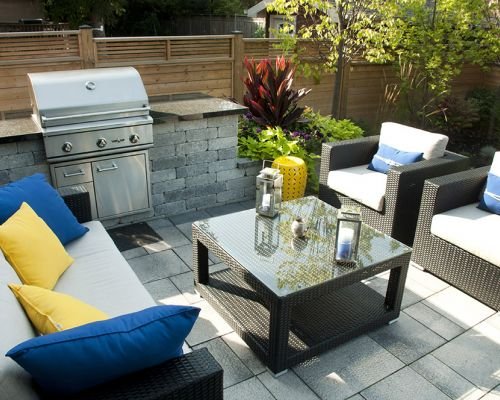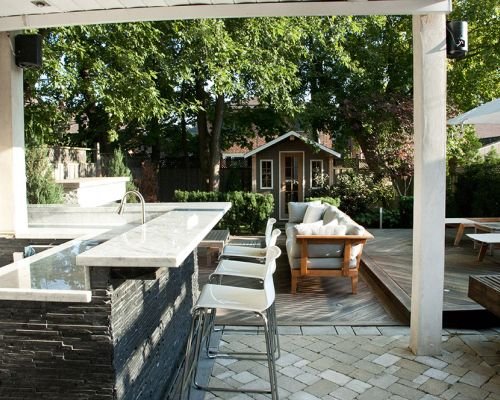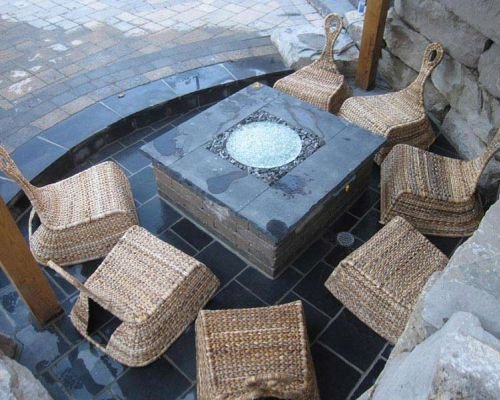Transforming Toronto yards into stunning, sustainable retreats isn’t just about beauty—it’s a delicate balance of ecological responsibility and personal style. How can homeowners create outdoor spaces that are not only inviting and functional but also environmentally sound? This compelling guide explores innovative strategies like native plants, eco-friendly hardscaping, and smart irrigation that thrive in Toronto’s climate. It emphasizes that thoughtful design, mindful maintenance, and adaptive features turn ordinary yards into resilient sanctuaries—spaces that support local ecosystems while reducing ongoing costs. But beyond aesthetics, these landscapes address real urban challenges such as stormwater management and biodiversity loss. The journey toward a sustainable outdoor oasis is ongoing, requiring a blend of innovative practices and dedicated care. Are you ready to turn your yard into a personal, eco-conscious retreat that sustains and inspires long-term enjoyment?
Transform Your Toronto Outdoor Space with Expert Landscape Design
Looking to enhance your Toronto backyard? Toronto Landscape & Design (TLD) specializes in creating stunning outdoor environments tailored to your needs. Our award-winning designers consider every detail, from natural stone features to water gardens, irrigation systems, and durable retaining walls. Whether you’re dreaming of a lush oasis or a functional outdoor space, we ensure your vision becomes reality. Discover how a professional backyard makeover can elevate your property’s beauty and value. Contact us today at mike@torontolandscapedesign.com or call 1.416.644.0499 to start your transformation.

Transforming Toronto Yards into Stunning, Eco-Friendly Retreats
Transforming Toronto yards into beautiful, sustainable outdoor retreats is more than just a trend—it’s a smart way for homeowners to enhance their outdoor spaces while respecting the environment. As demand grows for yards that are both eye-catching and eco-friendly, the challenge lies in balancing aesthetic appeal with ecological responsibility. Achieving this harmony requires thoughtful planning, focusing on native plants, eco-friendly materials, and climate-aware design principles.
Today’s outdoor spaces are often an extension of the home, serving as places to relax, entertain, and connect with nature. Torontonians want yards that reflect their personal style but also support local ecosystems and reduce environmental impact. This means selecting resilient native plants, incorporating sustainable hardscaping, and designing layouts that minimize water use and maintenance. When these elements come together, they create outdoor retreats that are as functional as they are visually stunning.
Understanding what homeowners truly want from their yards is key. Some prioritize lush gardens, while others seek low-maintenance features or outdoor entertaining zones. Listening carefully to these preferences ensures the final design aligns with their lifestyle, resulting in a space that feels both personal and sustainable. This client-focused approach, combined with environmentally conscious practices, helps deliver outdoor spaces that inspire and satisfy.
As Toronto’s landscape scene evolves, so do the strategies for creating impactful outdoor environments. Innovations like native plant gardens, eco-friendly hardscaping, and smart irrigation systems make sustainable landscaping more accessible and effective. By integrating these elements into design and installation, professionals can craft outdoor areas that thrive in Toronto’s climate and stand the test of time.
Balancing beauty, sustainability, and client satisfaction isn’t a one-time effort. It’s a continuous process of thoughtful planning, adaptive design, and mindful maintenance. When done well, it transforms ordinary yards into personal sanctuaries—spaces that are beautiful, environmentally responsible, and tailored to each homeowner’s unique needs. This approach ensures that every outdoor retreat becomes a long-lasting source of enjoyment and pride.
Foundations of Sustainable Landscaping in Toronto
Landscape design in Toronto has come a long way, shaped by shifting styles, growing environmental awareness, and technological advances. In the past, yards were mostly functional spaces with simple lawns and basic plantings, often without much thought for sustainability. Today, the emphasis is on creating outdoor environments that blend beauty with eco-conscious practices. Native plants, water-efficient systems, and sustainable materials are now standard, helping gardens flourish while reducing their ecological footprint.
Toronto’s climate plays a crucial role in guiding landscape choices. With cold winters and warm summers, designers focus on resilient, low-maintenance plants adapted to seasonal shifts. Native species are especially valued because they thrive naturally in local soil and weather conditions. This regional focus results in landscapes that are more durable, easier to care for, and aligned with the city’s sustainability goals. Incorporating native plants not only supports local ecosystems but also minimizes resource use, making gardens both beautiful and environmentally responsible.
Modern landscape principles stress harmony, functionality, and longevity. Using native flora reduces water needs and chemical inputs, while sustainable hardscaping—like permeable pavers and recycled materials—helps manage stormwater effectively. These practices contribute to healthier neighborhoods and outdoor spaces that require less ongoing maintenance. As Toronto adopts greener strategies, these adaptive design approaches ensure outdoor areas remain resilient, inviting, and capable of thriving through all seasons.
Designing visually appealing yards in Toronto involves careful layout and thoughtful focal points. Strategic placement of trees, water features, or sculptures creates visual interest and guides the eye naturally through the space. Choosing textures, colors, and materials that complement each other results in cohesive, inviting environments. When paired with sustainable practices, these design choices transform ordinary yards into personalized outdoor retreats that balance aesthetic appeal with environmental responsibility.
Understanding homeowner priorities is essential for successful landscape projects. Designers often begin by discussing lifestyle preferences, aesthetic tastes, and specific needs. Tools like mood boards or digital renderings help clarify ideas and ensure alignment. Considering how the space will be used—whether for relaxing, gardening, or entertaining—shapes layout and feature choices. Clear communication throughout the process guarantees the final result meets both functional and sustainability goals.
Eco-friendly practices now form the backbone of Toronto’s landscape renovations. Using native plants supports pollinators and reduces water consumption, while recycled and reclaimed materials lower waste. Installing water-saving irrigation systems and organic fertilizers further enhances sustainability. These small but impactful choices create gardens that are not only visually stunning but also responsible, aligning with Toronto’s broader environmental targets and helping residents reduce their ecological footprint.

Current Trends Shaping Toronto’s Outdoor Spaces
Toronto’s outdoor landscaping scene is more dynamic and diverse than ever, reflecting a blend of modern trends and time-tested practices. Many homeowners now lean toward low-maintenance, eco-friendly gardens that maximize small spaces and withstand Toronto’s unpredictable weather. Native plants are especially popular—they’re naturally adapted to the climate, requiring less water and fewer chemicals, which makes upkeep simpler and more sustainable. Meanwhile, hardscaping elements like permeable pavers and recycled stone are gaining traction, helping manage stormwater runoff while adding visual interest.
Technological advances continue to reshape outdoor spaces. Smart irrigation systems that adjust watering based on weather conditions conserve water and keep plants healthy. Outdoor lighting controlled via apps creates inviting atmospheres for evening gatherings. These innovations support a lifestyle that values convenience and sustainability, turning ordinary yards into functional retreats that are both attractive and eco-friendly.
Toronto’s harsh winters and humid summers heavily influence design choices. Many homeowners seek gardens that look vibrant year-round, favoring hardy native plants that endure seasonal shifts. Limited space in urban settings pushes designers to think creatively—combining multi-purpose features like patios for dining, lounging, and entertaining. These adaptations help keep outdoor areas appealing and usable throughout the year, regardless of weather or space constraints.
While contemporary trends dominate, traditional landscaping remains relevant for those valuing reliability and affordability. Classic lawns, established plant varieties, and straightforward hardscaping like pathways and patios continue to be popular. Many homeowners now blend these timeless elements with sustainable innovations, creating outdoor spaces that balance enduring appeal with environmental responsibility.
Innovations like green roofs and living walls are transforming Toronto’s outdoor landscape into more than just backyards. These features maximize limited space, improve air quality, and add visual interest, especially in dense urban environments. Recycled materials such as concrete and bamboo are increasingly incorporated, aligning aesthetic appeal with eco-conscious values. This shift toward innovative, sustainable features reflects a broader desire for smarter, greener outdoor environments that support local ecosystems and enhance city living.
Overall, Toronto’s outdoor landscaping is evolving into a sophisticated mix of style, sustainability, and practicality. Homeowners and designers alike are embracing eco-friendly practices, native plants, and innovative features to create outdoor retreats that are resilient, beautiful, and environmentally responsible. The landscape of today’s Toronto yards is a testament to thoughtful design—one that prioritizes long-term beauty and ecological health, ensuring these outdoor spaces remain vibrant and sustainable for years to come.
Smart Budgeting for Beautiful, Eco-Conscious Gardens
Creating a sustainable outdoor space in Toronto requires careful financial planning from the start. Knowing the full scope of costs—including design, materials, installation, and ongoing maintenance—helps homeowners set realistic budgets and avoid surprises. While eco-friendly features may come with a higher initial price tag, they often lead to long-term savings through reduced water, energy, and upkeep expenses.
Design fees vary depending on the project’s complexity and the landscape professional’s expertise. These costs typically cover site analysis, conceptual plans, and detailed drawings that ensure your vision is accurately realized. Material choices—such as native plants and recycled hardscaping—significantly influence your budget. Although eco-conscious options might cost more upfront, they generally require less care and fewer resources over time, making them a smart investment.
Installation costs are driven by yard size and the intricacy of work involved, like excavation or hardscape construction. Planning for these expenses early helps align your aesthetic goals with your financial limits. Don’t forget ongoing maintenance costs, which tend to be lower with sustainable landscapes. Features like water-efficient irrigation and organic fertilizers further reduce long-term expenses, keeping your outdoor retreat both beautiful and cost-effective.
For those working within tighter budgets, options still abound. Native plants are budget-friendly—they thrive naturally, needing less water and fewer chemicals. Using recycled or locally sourced materials for hardscaping also cuts costs while supporting sustainability. Prioritizing multi-functional elements, such as combined patios and seating areas, maximizes utility without added expense. Small DIY projects, like planting a vegetable garden or installing simple lighting, can make a big difference without breaking the bank.
While the initial investment in eco-friendly features might seem higher, the savings over time are compelling. Reduced water use, lower energy bills, and less frequent replacements make these landscapes more economical in the long run. A well-planned, sustainable yard not only enhances your property’s value but also aligns with your financial and environmental goals.
Budgeting effectively involves anticipating unforeseen costs, like drainage issues or material shortages. Setting aside an emergency fund ensures your project can adapt without delays. Working with professionals during planning helps identify potential overruns early, saving money and reducing stress. Comparing quotes and researching options ensures you choose solutions that fit your financial comfort zone.
In the end, balancing cost with value creates a landscape that remains stunning and sustainable for years. Smart planning, realistic budgeting, and prioritizing long-term savings turn your outdoor space into a true investment—one that offers beauty, resilience, and environmental responsibility all in one.
Real-Life Success Stories of Sustainable Toronto Yards
Well-designed, sustainable landscapes in Toronto have a real, tangible impact on daily life. Many homeowners discover that thoughtful choices—like native plants that flourish without constant watering or chemical treatments—make their gardens more inviting and easier to care for. For families with young children or pets, low-maintenance yards become a blessing, reducing the time and effort needed for upkeep and allowing more time to enjoy the outdoors. These gardens stay lush and vibrant through Toronto’s seasons, making outdoor living more accessible and less stressful.
Practical features like rain gardens and permeable pavers do more than look good; they address real challenges like managing heavy stormwater. For example, transforming a storm-prone backyard into a lush oasis with a rain garden not only beautifies the space but also reduces flooding and runoff, protecting local waterways. These solutions turn problem areas into assets, helping homeowners feel more confident in their outdoor spaces regardless of weather extremes.
Outdoor living areas—think patios, fire pits, and seating zones—are now more durable and functional thanks to sustainable hardscaping. Recycled stone and permeable pavers create sturdy surfaces that withstand Toronto’s seasonal shifts, supporting gatherings and family evenings well into the year. These features require less maintenance and contribute to the overall resilience of the landscape, making outdoor enjoyment seamless and hassle-free.
Native plants attract local pollinators like bees and butterflies, adding life and movement to the yard while supporting biodiversity. One Toronto family transformed their overgrown backyard into a pollinator-friendly haven, planting native shrubs and wildflowers that drew in hummingbirds and butterflies. This not only enhanced the beauty of their space but also deepened their connection to the surrounding ecosystem, turning their yard into a lively sanctuary.
Beyond aesthetics, these landscapes foster a sense of tranquility and connection. A well-planned, eco-friendly yard becomes a personal retreat, offering privacy and serenity amid urban life. Families and friends gather comfortably, knowing their outdoor space respects the environment while providing a welcoming atmosphere. These examples show how sustainable design goes beyond appearance—transforming outdoor spaces into functional, joyful places that enrich daily living and support Toronto’s local ecosystems.

Maintaining Beauty and Eco-Responsibility for Years to Come
Maintaining the beauty and sustainability of your Toronto outdoor retreat requires consistent, eco-friendly practices that support long-term health. Regular mulching around plants conserves soil moisture, suppresses weeds, and naturally enriches the soil, reducing the need for chemical herbicides. Pruning native plants at appropriate times encourages vigorous growth and maintains a tidy appearance without stressing the plants, helping them thrive season after season.
Smart irrigation systems equipped with moisture sensors or timers are essential tools. They deliver just the right amount of water, preventing waste and runoff while keeping your plants healthy. Adjusting watering schedules to match seasonal needs ensures resilience during hot, dry periods and protects against overwatering during rainier months. Flexibility in your landscape design also allows for small updates, such as reconfiguring plantings or adding new features, keeping your yard vibrant and functional without major renovations.
Eco-conscious maintenance extends beyond watering. Choose biodegradable or recycled products for cleanup, and opt for organic pest control methods to support pollinators and soil health. Regular landscape assessments help identify issues early—such as drainage problems or overgrown areas—so you can address them before they escalate, maintaining a tidy, healthy environment.
Design elements should be adaptable to changing conditions. Modular features like movable planters or seating allow you to refresh your space as plants mature or seasons shift. This flexibility makes it easier to keep your yard looking its best and functioning well over time, without the need for costly overhaul.
Engaging professional landscape maintenance services periodically can help sustain your yard’s health and appearance. Experts offer tailored advice, seasonal cleanups, and eco-friendly solutions that align with your sustainability goals. Their insights help you stay proactive, ensuring your outdoor space remains a thriving, environmentally responsible sanctuary.
Staying informed about new sustainable practices and materials is key. Incorporate innovations like drought-resistant native plants or water-saving irrigation upgrades as they become available. Regular updates and thoughtful adjustments keep your landscape resilient, reducing environmental impact and enhancing its longevity.
Ultimately, preserving your outdoor retreat’s beauty and sustainability is an ongoing journey. By adopting mindful habits, making strategic updates, and working harmoniously with nature, your yard can continue to serve as a stunning, eco-friendly haven for years to come.